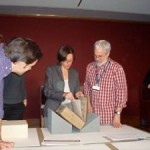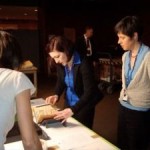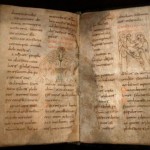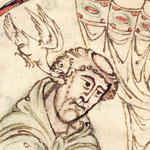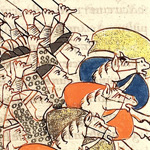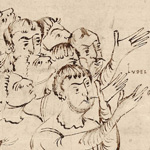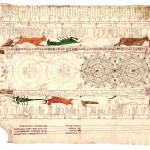Tuesday, August 25, 2009
The special exhibition Pen and Parchment: Drawing in the Middle Ages closed on Sunday, August 23. Although my colleagues and I will no longer be writing new posts, we will continue to publish your comments and answer your questions for the next few weeks.
Many of you will also be interested in the Museum’s upcoming exhibition The Art of Illumination: The Limbourg Brothers and the Belles Heures of Jean de France, Duc de Berry, opening March 2, 2010, which will focus on one of the masterpieces of medieval book illumination.
Thank you for your interest and participation in this exciting project.
—Melanie Holcomb
Citation:
Holcomb, Melanie. “Post title.” Pen and Parchment: Drawing in the Middle Ages. (/penandparchment/). The Metropolitan Museum of Art. Blog. Date of access.
Tags: belles heures
Posted by Melanie Holcomb on Tuesday, August 25 at 4:56 pm | Comments (4)
Tuesday, August 18, 2009
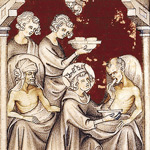
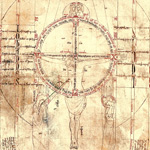
Above: Jean Pucelle (active ca. 1320–1324) Saint Louis Feeding the Sick from The Book of Hours of Jeanne d’Evreux Paris, France, 1324–28, 3 1/2 x 2 5/8 in. (8.9 x 6.2 cm), The Metropolitan Museum of Art, New York; The Cloisters Collection, 1954 (54.1.2); Opicinus de Canistris (1296–ca. 1354) Diagram with Crucifixion, Avignon, France; 1335–50, Biblioteca Apostolica Vaticana, Vatican City, Pal. Lat. 1993.
In last week’s post I discussed the earliest drawings in the exhibition, the initials in the Corbie Psalter, which date to around 800. I began the exhibition with this work because I have long felt the two anonymous scribe-artists responsible for the book were among the first great medieval draftsmen. They understood the power of the drawn line. Their expressive impulse seemed to derive organically from the words they were writing. Read more »
Tags: crucifixion, Hours of Jeanne d'Evreux, jean pucelle, Opicinus de Canestris, saint louis
Posted by Melanie Holcomb on Tuesday, August 18 at 2:18 pm | Comments (0)
Tuesday, August 11, 2009
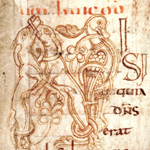
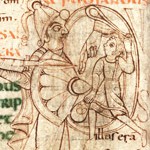
Above: Zoomorphic Initial (detail) and Initial P (detail), From the Corbie Psalter, Corbie, France, early 9th century. Bibliothèques d’Amiens Métropole, MS 18C
One point I have stressed in both the exhibition and its accompanying catalogue is the intimate relationship that existed in the Middle Ages between drawing and the written word. Few works better illustrate this point than the Corbie Psalter, created around 800. This endlessly fascinating book contains both the Psalms and the Canticles (the songs in the Bible that are not Psalms). Its illustrations consist entirely of remarkably inventive initials for the first letter of the first word of each text. Read more »
Tags: Corbie Psalter, Psalm 123, zoomorphic
Posted by Melanie Holcomb on Tuesday, August 11 at 5:47 pm | Comments (0)
Tuesday, August 4, 2009
Above: Two photos during the installation of the exhibition show the process of opening pages; the new opening from the Corbie Psalter now on view in the galleries.
A few days ago we turned the pages in three of the manuscripts on view so that we can show different “openings,” or double-page spreads. If you have a chance to visit the exhibition again, you’ll notice a new set of images for the Hours of Jeanne d’Evreux, the Prato Haggadah, and the Corbie Psalter. The new opening from the little book of hours for Jeanne d’Evreux includes an image of the Miracle of the Breviary, in which a dove wondrously returns to an imprisoned Saint Louis a prayer book that had been lost in battle. In the Prato Haggadah, we are now showing the pages for the “Dayyeinu” portion of the Passover seder, in which the words of the refrain are set within a Gothic tower. I admit that my favorite new opening is the one that shows the initial M and the initial N from the Corbie Psalter (See a more detailed image of the initial N.) The M of the word Magnificat—formed by the bodies of Elizabeth and Mary—is one of the most inventive depictions of the Visitation I know. Read more »
Tags: Corbie Psalter, Hours of Jeanne d'Evreux, Miracle of the Breviary, opening, pages, Prato Haggadah, seder, turning, visitation
Posted by Melanie Holcomb on Tuesday, August 4 at 4:39 pm | Comments (2)
Friday, July 31, 2009
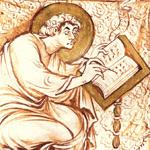
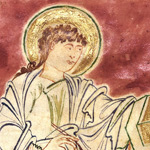
Above: Evangelist Luke, From the Morgan Gospels, Northeast France, second half of the 9th century, 9 5/8 x 8 1/4 in. (24.5 x 21 cm), The Pierpont Morgan Library, New York. Purchase by John Pierpont Morgan, Jr., 1919. MS M. 640; Evangelist Matthew, From the Arenberg Gospels, Canterbury, England, ca. 1000–1020, The Pierpont Morgan Library, New York, M. 869.
One point that I’ve emphasized in the exhibition is that though we normally think of drawing as a preparatory exercise—a way to explore an idea or map out a composition—medieval artists and patrons, particularly in the early Middle Ages, often thought of drawing as a finished product, worthy of important and luxury books. Some artists even made use of gold to embellish their drawings. Though it wasn’t my intent, the exhibition provides a nice survey of gilding techniques. Read more »
Tags: copper, gesso, gilding, gold, gold leaf, green-gold, patina, pigment, verdigris
Posted by Melanie Holcomb on Friday, July 31 at 10:16 am | Comments (2)
Thursday, July 23, 2009
Associate Curator Melanie Holcomb discussed the exhibition on The Leonard Lopate Show on Friday, July 17. Go to the WNYC website to listen to the interview.
Posted by Eileen Willis on Thursday, July 23 at 5:24 pm | Comments (0)
Tuesday, July 21, 2009
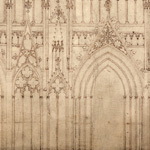
Above: Façade of Strasbourg Cathedral (“Plan A1”), Strasbourg, France, 1260s, 33 7/8 x 23 1/4 in. (86 x 59 cm), Musée de l’Oeuvre Notre-Dame, Strasbourg, Inv. no. 2.
The so-called Strasbourg Plan A1, seen above, offers an exquisite example of medieval architectural drawings, which are rarely accessible to anyone, including scholars and researchers. It is one of the earliest surviving graphic documents of a monumental structure, authored by an anonymous artist. Although we do not know his name, the artist left us with enough information, in pen and ink, to express his vision for the design of the west façade of Strasbourg cathedral. Read more »
Tags: architecture, compass, Strasbourg
Posted by Nancy Wu on Tuesday, July 21 at 10:43 am | Comments (5)
Tuesday, July 14, 2009
Above, from left to right: Saint Jerome (detail), from Life of Saint Paul by Jerome and Life of Saint Guthlac, England, probably Canterbury, probably 2nd quarter of 11th century, Corpus Christi College, Cambridge, MS 389; Battle Scene (detail), from Book of Maccabees I, Saint Gall, Switzerland, second half of 9th–early 10th century, Universiteitsbibliotheek, Leiden, Cod. Perizoni F.17; Saint Paul Preaching to the Jews and Gentiles of Rome (detail), from the Pauline Epistles, Saint Gall, Switzerland; second half of ninth century Stiftsbibliothek, Saint Gall, Cod. 64.
The exuberant drawing of Saint Jerome with a quill in his right hand, its tip pressed against the ruled pages of an open book, and, in his left hand, a knife used for sharpening the quill and scraping away mistakes, provides a memorable image of the scribe at work. I’ve always marveled at the resourcefulness of medieval scribes and artists in terms of the preparation of their tools and materials. As if the process of creating folios of parchment were not expensive and time-consuming enough, artists also had to prepare their own pigments and pens. Read more »
Tags: cochineal, gum, ink, lapis lazuli, Leiden, Maccabees, madder, minium, ocher, polysaccharide, Saint Gall
Posted by Betsy Williams on Tuesday, July 14 at 8:29 am | Comments (17)
Tuesday, July 7, 2009
Above, from left to right: Jean Pucelle (active ca. 1320–1324), Saint Louis Feeding the Sick (detail), From The Book of Hours of Jeanne d’Evreux, Paris, France, 1324–28, The Metropolitan Museum of Art, New York, The Cloisters Collection, 1954 (54.1.2); Opicinus de Canistris (1296–ca. 1354), Diagram with Zodiac Symbols (detail), Avignon, France, 1335–50, Biblioteca Apostolica Vaticana, Vatican City, Pal. Lat. 1993.
Often when I view medieval manuscripts I become so focused on the words and pictures adorning the pages that I forget to take note of the materials with which they were created. Yet after traveling through this exhibition, it becomes strikingly evident that the materials themselves—the parchment and ink—are as important as the narratives they contain. Read more »
Tags: Jeanne d'Evreux, Opicinus de Canistris, parchment, pergamenum, pergamum, Salomon Glossaries, vellum
Posted by Eric Hupe on Tuesday, July 7 at 2:47 pm | Comments (5)
Tuesday, June 30, 2009
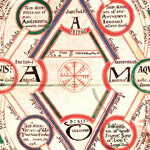
Above: Byrhtferth’s Diagram; Computus Diagrams (detail), from the Thorney Computus, Cambridgeshire, England, ca. 1102–10, Saint John’s College, Oxford, MS 17.
I have long been fascinated by medieval diagrams. Even before this exhibition provided the opportunity to unpack their often arcane content, I appreciated their elegant geometry. Although the systems of thought and basic formats of these diagrams often come from antiquity, I like to think their aesthetic potential was only fully realized by medieval thinkers and draftsmen. Read more »
Tags: Byrhtferth, computus, Consanguinity Chart, Edward Tufte, Faith Wallis, Isidore of Seville, quaternities, Ramsey Abbey, Thorney Abbey, Thorney Computus
Posted by Melanie Holcomb on Tuesday, June 30 at 3:48 pm | Comments (6)
Monday, June 22, 2009
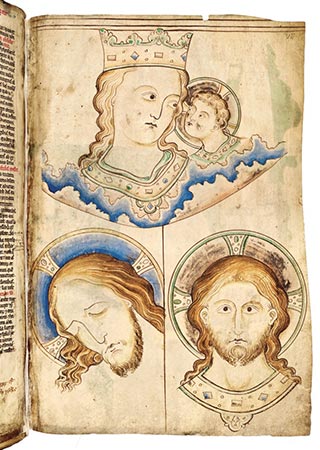
Above: Matthew Paris (ca. 1200–1259). The Virgin and Christ Child; Christ Crucified; Christ in Majesty. From Chronica Majora, vol. 1. Saint Albans, England, ca. 1240–53. Corpus Christi College Library, Cambridge, MS 26.
During the course of preparing this exhibition, I felt I came to know many of the draftsmen featured in the exhibition quite well. Their distinctive way with the pen would appear in a new [to me] manuscript, and I felt I was reacquainting myself with an old friend. Of course, we don’t know most of the names of these draftsmen, but one whose name is well known, at least among students of the Middle Ages, is Matthew Paris, a monk who lived in the first half of the thirteenth century. Read more »
Tags: Chronica Majora, Jacquemart de Hesdin, Matthew Paris, Saint Albans, Suzanne Lewis
Posted by Melanie Holcomb on Monday, June 22 at 2:25 pm | Comments (3)
Tuesday, June 16, 2009
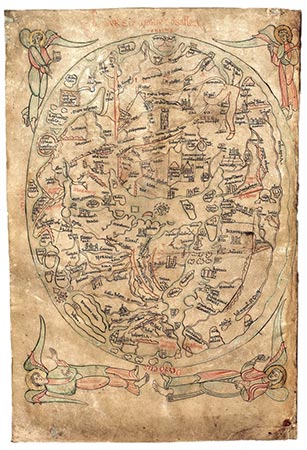
Above: The Sawley Map (detail). From the Imago mundi by Honorius Augustodunensis. England, probably Durham, ca. 1190. Corpus Christi College, Cambridge, MS 66, Part 1.
Today, we look at maps to help us get somewhere, or to show us geological or geographic features of a place. In the Middle Ages, some maps were certainly drawn for the same purpose. One example, a famous atlas created by the Islamic cartographer Il-Idrisi for the Norman king Roger II in Sicily, includes Europe, Asia, and parts of Africa, and is often praised today for its relative accuracy. Its sixty-six sections describe countries, their principal cities, roads, borders, waterways, and mountains. (See images of a thirteenth-century copy of this map at the Bibliothèque nationale de France.) Read more »
Tags: Il-Idrisi, Imago Mundi, map, Sawley Map
Posted by Melanie Holcomb on Tuesday, June 16 at 11:40 am | Comments (5)





